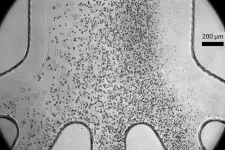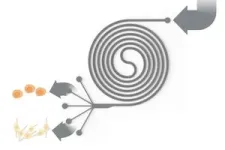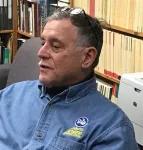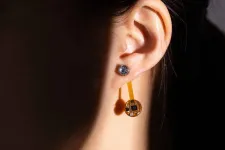(Press-News.org) CAMBRIDGE, MA – A tiny device built by scientists at MIT and the Singapore-MIT Alliance for Research and Technology could be used to improve the safety and effectiveness of cell therapy treatments for patients suffering from spinal cord injuries.
In cell therapy, clinicians create what are known as induced pluripotent stem cells by reprogramming some skin or blood cells taken from a patient. To treat a spinal cord injury, they would coax these pluripotent stem cells to become progenitor cells, which are destined to differentiate into spinal cord cells. These progenitors are then transplanted back into the patient.
These new cells can regenerate part of the injured spinal cord. However, pluripotent stem cells that don’t fully change into progenitors can form tumors.
This research team developed a microfluidic cell sorter that can remove about half of the undifferentiated cells — those that can potentially become tumors — in a batch, without causing any damage to the fully-formed progenitor cells.
The high-throughput device, which doesn’t require special chemicals, can sort more than 3 million cells per minute. In addition, the researchers have shown that chaining many devices together can sort more than 500 million cells per minute, making this a more viable method to someday improve the safety of cell therapy treatments.
Plus, the plastic chip that contains the microfluidic cell sorter can be mass-produced in a factory at very low cost, so the device would be easier to implement at scale.
“Even if you have a life-saving cell therapy that is doing wonders for patients, if you cannot manufacture it cost-effectively, reliably, and safely, then its impact might be limited. Our team is passionate about that problem — we want to make these therapies more reliable and easily accessible,” says Jongyoon Han, an MIT professor of electrical engineering and computer science and of biological engineering, a member of the Research Laboratory of Electronics (RLE), and co-lead principal investigator of the CAMP (Critical Analytics for Manufacturing Personalized Medicine) research group at the Singapore-MIT Alliance for Research and Technology (SMART).
Han is joined on the paper by co-senior author Sing Yian Chew, professor of chemistry, chemical engineering, and biotechnology at the Lee Kong Chian School of Medicine and Materials Science and Engineering at Nanyang Technological University in Singapore and a CAMP principal investigator; co-lead authors Tan Dai Nguyen, a CAMP researcher; Wai Hon Chooi, a senior research fellow at the Singapore Agency for Science, Technology, and Research (A*STAR); and Hyungkook Jeon, an MIT postdoc; as well as others at NTU and A*STAR. The research appears today in Stem Cells Translational Medicine.
Reducing risk
The cancer risk posed by undifferentiated induced pluripotent stem cells remains one of the most pressing challenges in this type of cell therapy.
“Even if you have a very small population of cells that are not fully differentiated, they could still turn into cancer-like cells,” Han adds.
Clinicians and researchers often seek to identify and remove these cells by looking for certain markers on their surfaces, but so far researchers have not been able to find a marker that is specific to these undifferentiated cells. Other methods use chemicals to selectively destroy these cells, yet the chemical treatment techniques may be harmful to the differentiated cells.
The high-throughput microfluidic sorter, which can sort cells based on size, had been previously developed by the CAMP team after more than a decade of work. It has been previously used for sorting immune cells and mesenchymal stromal cells (another type of stem cell), and now the team is expanding its use to other stem cell types, such as induced pluripotent stem cells, Han says.
“We are interested in regenerative strategies to enhance tissue repair after spinal cord injuries, as these conditions lead to devasting functional impairment. Unfortunately, there is currently no effective regenerative treatment approach for spinal cord injuries,” Chew says. “Spinal cord progenitor cells derived from pluripotent stem cells hold great promise, since they can generate all cell types found within the spinal cord to restore tissue structure and function. To be able to effectively utilize these cells, the first step would be to ensure their safety, which is the aim of our work.”
The team discovered that pluripotent stem cells tend to be larger than the progenitors derived from them. It is hypothesized that before a pluripotent stem cell differentiates, its nucleus contains a large number of genes that haven’t been turned off, or suppressed. As it differentiates for a specific function, the cell suppresses many genes it will no longer need, significantly shrinking the nucleus.
The microfluidic device leverages this size difference to sort the cells.
Spiral sorting
Microfluidic channels in the quarter-sized plastic chip form an inlet, a spiral, and four outlets that output cells of different sizes. As the cells are forced through the spiral at very high speeds, various forces, including centrifugal forces, act on the cells. These forces counteract to focus the cells in a certain location in the fluid stream. This focusing point will be dependent on the size of the cells, effectively sorting them through separate outlets.
The researchers found they could improve the sorter’s operation by running it twice, first at a lower speed so larger cells stick to the walls and smaller cells are sorted out, then at a higher speed to sort out larger cells.
In a sense, the device operates like a centrifuge, but the microfluidic sorter does not require human intervention to pick out sorted cells, Han adds.
The researchers showed that their device could remove about 50 percent of the larger cells with one pass. They conducted experiments to confirm that the larger cells they removed were, in fact, associated with higher tumor risk.
“While we can’t remove 100 percent of these cells, we still believe this is going to reduce the risk significantly. Hopefully, the original cell type is good enough that we don’t have too many undifferentiated cells. Then this process could make these cells even safer,” he says.
Importantly, the low-cost microfluidic sorter, which can be produced at scale with standard manufacturing techniques, does not use any type of filtration. Filters can become clogged or break down, so a filter-free device can be used for a much longer time.
Now that they have shown success at a small scale, the researchers are embarking on larger studies and animal models to see if the purified cells function better in vivo.
Nondifferentiated cells can become tumors, but they can have other random effects in the body, so removing more of these cells could boost the efficacy of cell therapies, as well as improve safety.
“If we can convincingly demonstrate these benefits in vivo, the future might hold even more exciting applications for this technique,” Han says.
###
This research is supported, in part, by the National Research Foundation of Singapore and the Singapore-MIT Alliance for Research and Technology.
END
Scientists develop a low-cost device to make cell therapy safer
A plastic microfluidic chip can remove some risky cells that could potentially become tumors before they are implanted in a patient.
2024-02-07
ELSE PRESS RELEASES FROM THIS DATE:
Getting to know the ‘ghost’ inside batteries
2024-02-07
An Argonne team developing materials for solid-state batteries took an unexpected detour to investigate tiny short-circuits known as soft-shorts. Their insights will benefit battery researchers around the world.
Researchers at the U.S. Department of Energy’s (DOE) Argonne National Laboratory have shed important new light on what the early signs of battery failure look like. Their study — which relates to a condition called soft-shorts — provides the research community with valuable knowledge and methods to design better electric vehicle (EV) batteries.
The Argonne team’s research focused on all-solid batteries with anodes (negative electrodes) ...
Predicting neurodevelopmental disease in children from parent’s traits
2024-02-07
UNIVERSITY PARK, Pa. — Predicting the trajectory of neurodevelopmental and psychiatric disorders like autism or schizophrenia is difficult because they can be influenced by many different genetic and environmental factors. A new study, led by Penn State researchers, demonstrates that evaluating parents for their manifestation of traits of these disorders — and related diseases like depression and anxiety — may provide a more accurate method of predicting the prevalence, and potentially severity, of the disorders in affected children than screening for genetic variants alone. This is likely due, at least in part, to genetic variants the parents transmit to the ...
New species of 65 million year old fossil shark discovered in Alabama, USA
2024-02-07
Birmingham, AL (February 7, 2024) – Today, a team of scientists is pleased to announce the discovery of a new fossil shark species from Alabama, USA. The team is led by Jun Ebersole, Director of Collections, McWane Science Center, Birmingham, AL, David Cicimurri, Curator of Natural History, South Carolina State Museum in Columbia, and T. Lynn Harrell, Jr., Paleontologist and Fossil Collections Curator at the Geological Survey of Alabama in Tuscaloosa.
The shark is a new species of Palaeohypotodus (pronounced pale-ee-oh-hype-oh-toe-duss), which means “ancient small-eared tooth,” in reference to the small needle-like fangs present on the sides of the teeth. It has ...
Time to treatment with intravenous thrombolysis before thrombectomy and functional outcomes in acute ischemic stroke
2024-02-07
About The Study: In patients presenting at thrombectomy-capable stroke centers, the benefit associated with intravenous thrombolysis (IVT) plus thrombectomy versus thrombectomy alone was time dependent and statistically significant only if the time from symptom onset to expected administration of IVT was short in this individual participant data meta-analysis (n = 2,313) of six randomized clinical trials.
Authors: Johannes Kaesmacher, M.D., Ph.D., of the University of Bern in Bern, Switzerland, is the corresponding author.
To access the embargoed study: Visit ...
Many hookah manufacturers have not complied with FDA-mandated nicotine warning labels
2024-02-07
FOR IMMEDIATE RELEASE
February 7, 2024
Contact:
Jillian McKoy, jpmckoy@bu.edu
Michael Saunders, msaunder@bu.edu
##
Many Hookah Manufacturers Have Not Complied with FDA-Mandated Nicotine Warning Labels
Only half of the hookah packages assessed in a new study included the required nicotine warnings, two years after this federal regulation was implemented to alert consumers about the health risks of nicotine addiction.
Since August 2018, the US Food & Drug Administration has mandated that all hookah (also known as waterpipe tobacco or shisha) manufacturers include a nicotine warning ...
Endovascular thrombectomy for large ischemic stroke across ischemic injury and penumbra profiles
2024-02-07
About The Study: In this exploratory analysis of a randomized clinical trial of 336 patients with extensive ischemic stroke, endovascular thrombectomy (EVT) improved clinical outcomes across a wide spectrum of infarct volumes, although enrollment of patients with minimal penumbra volume was low. In EVT-treated patients, clinical outcomes worsened as presenting ischemic injury estimates increased.
Authors: Amrou Sarraj, M.D., of University Hospital Cleveland Medical Center—Case Western ...
Apixaban to prevent recurrence after cryptogenic stroke in patients with atrial cardiopathy
2024-02-07
About The Study: In patients with cryptogenic stroke and evidence of atrial cardiopathy without atrial fibrillation, oral anticoagulant therapy with apixaban did not significantly reduce recurrent stroke risk compared with aspirin in this randomized clinical trial that included 1,015 participants.
Authors: Hooman Kamel, M.D., of Weill Cornell Medicine in New York, is the corresponding author.
To access the embargoed study: Visit our For The Media website at this link https://media.jamanetwork.com/
(doi:10.1001/jama.2023.27188)
Editor’s Note: Please see the article for additional information, including other authors, author contributions ...
MD Anderson research highlights for February 7, 2024
2024-02-07
HOUSTON ― The University of Texas MD Anderson Cancer Center’s Research Highlights showcases the latest breakthroughs in cancer care, research and prevention. These advances are made possible through seamless collaboration between MD Anderson’s world-leading clinicians and scientists, bringing discoveries from the lab to the clinic and back.
Recent developments at MD Anderson include a combination treatment for patients with acute myeloid leukemia (AML), the discovery of a molecular driver in metastatic breast cancer, an oral combination therapy for high-risk myelodysplastic syndromes (MDS) and chronic myelomonocytic leukemia (CMML), a novel method to mechanically destroy ...
UW-developed smart earrings can monitor a person’s temperature
2024-02-07
Smart accessories are increasingly common. Rings and watches track vitals, while Ray-Bans now come with cameras and microphones. Wearable tech has even broached brooches. Yet certain accessories have yet to get the smart touch.
University of Washington researchers introduced the Thermal Earring, a wireless wearable that continuously monitors a user’s earlobe temperature. In a study of six users, the earring outperformed a smartwatch at sensing skin temperature during periods of rest. It also showed promise for monitoring signs of stress, eating, exercise and ovulation.
The smart earring prototype is about ...
Quantum simulation with ultracold fermions unveils pairing pseudogap
2024-02-07
A research team led by Professors PAN Jianwei, YAO Xingcan, and CHEN Yu'ao from the University of Science and Technology of China (USTC) of the Chinese Academy of Sciences, have for the first time observed and quantitatively characterized the many-body pairing pseudogap in unitary Fermi gases. This achievement, pursued by the ultracold atomic community for nearly two decades, resolves longstanding debates regarding the existence of a pairing pseudogap in these gases. It also supports ...
LAST 30 PRESS RELEASES:
First Editorial of 2026: Resisting AI slop
Joint ground- and space-based observations reveal Saturn-mass rogue planet
Inheritable genetic variant offers protection against blood cancer risk and progression
Pigs settled Pacific islands alongside early human voyagers
A Coral reef’s daily pulse reshapes microbes in surrounding waters
EAST Tokamak experiments exceed plasma density limit, offering new approach to fusion ignition
Groundbreaking discovery reveals Africa’s oldest cremation pyre and complex ritual practices
First breathing ‘lung-on-chip’ developed using genetically identical cells
How people moved pigs across the Pacific
Interaction of climate change and human activity and its impact on plant diversity in Qinghai-Tibet plateau
From addressing uncertainty to national strategy: an interpretation of Professor Lim Siong Guan’s views
Clinical trials on AI language model use in digestive healthcare
Scientists improve robotic visual–inertial trajectory localization accuracy using cross-modal interaction and selection techniques
Correlation between cancer cachexia and immune-related adverse events in HCC
Human adipose tissue: a new source for functional organoids
Metro lines double as freight highways during off-peak hours, Beijing study shows
Biomedical functions and applications of nanomaterials in tumor diagnosis and treatment: perspectives from ophthalmic oncology
3D imaging unveils how passivation improves perovskite solar cell performance
Enriching framework Al sites in 8-membered rings of Cu-SSZ-39 zeolite to enhance low-temperature ammonia selective catalytic reduction performance
AI-powered RNA drug development: a new frontier in therapeutics
Decoupling the HOR enhancement on PtRu: Dynamically matching interfacial water to reaction coordinates
Sulfur isn’t poisonous when it synergistically acts with phosphine in olefins hydroformylation
URI researchers uncover molecular mechanisms behind speciation in corals
Chitin based carbon aerogel offers a cleaner way to store thermal energy
Tracing hidden sources of nitrate pollution in rapidly changing rural urban landscapes
Viruses on plastic pollution may quietly accelerate the spread of antibiotic resistance
Three UH Rainbow Babies & Children’s faculty elected to prestigious American Pediatric Society
Tunnel resilience models unveiled to aid post-earthquake recovery
Satellite communication systems: the future of 5G/6G connectivity
Space computing power networks: a new frontier for satellite technologies
[Press-News.org] Scientists develop a low-cost device to make cell therapy saferA plastic microfluidic chip can remove some risky cells that could potentially become tumors before they are implanted in a patient.






